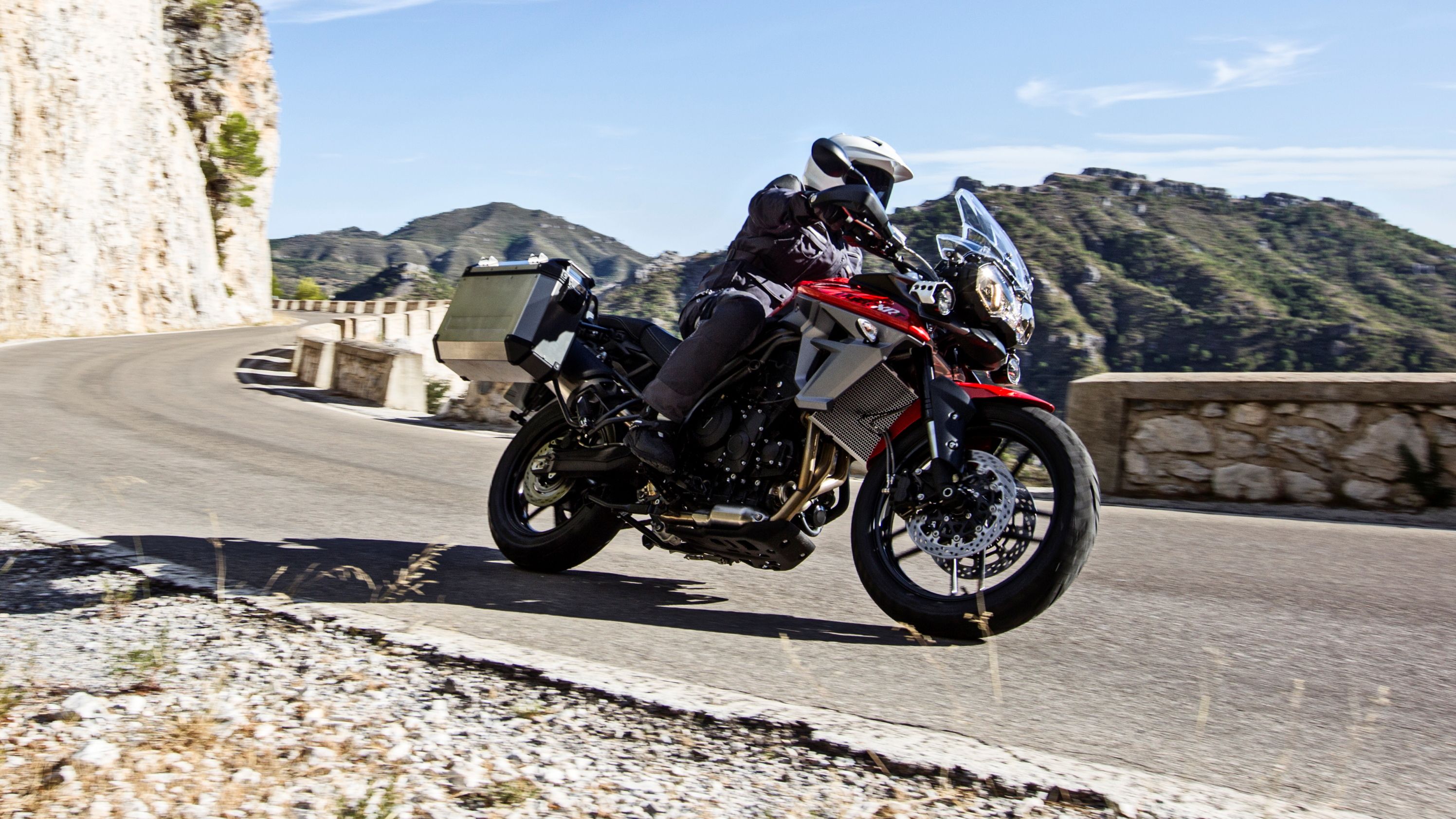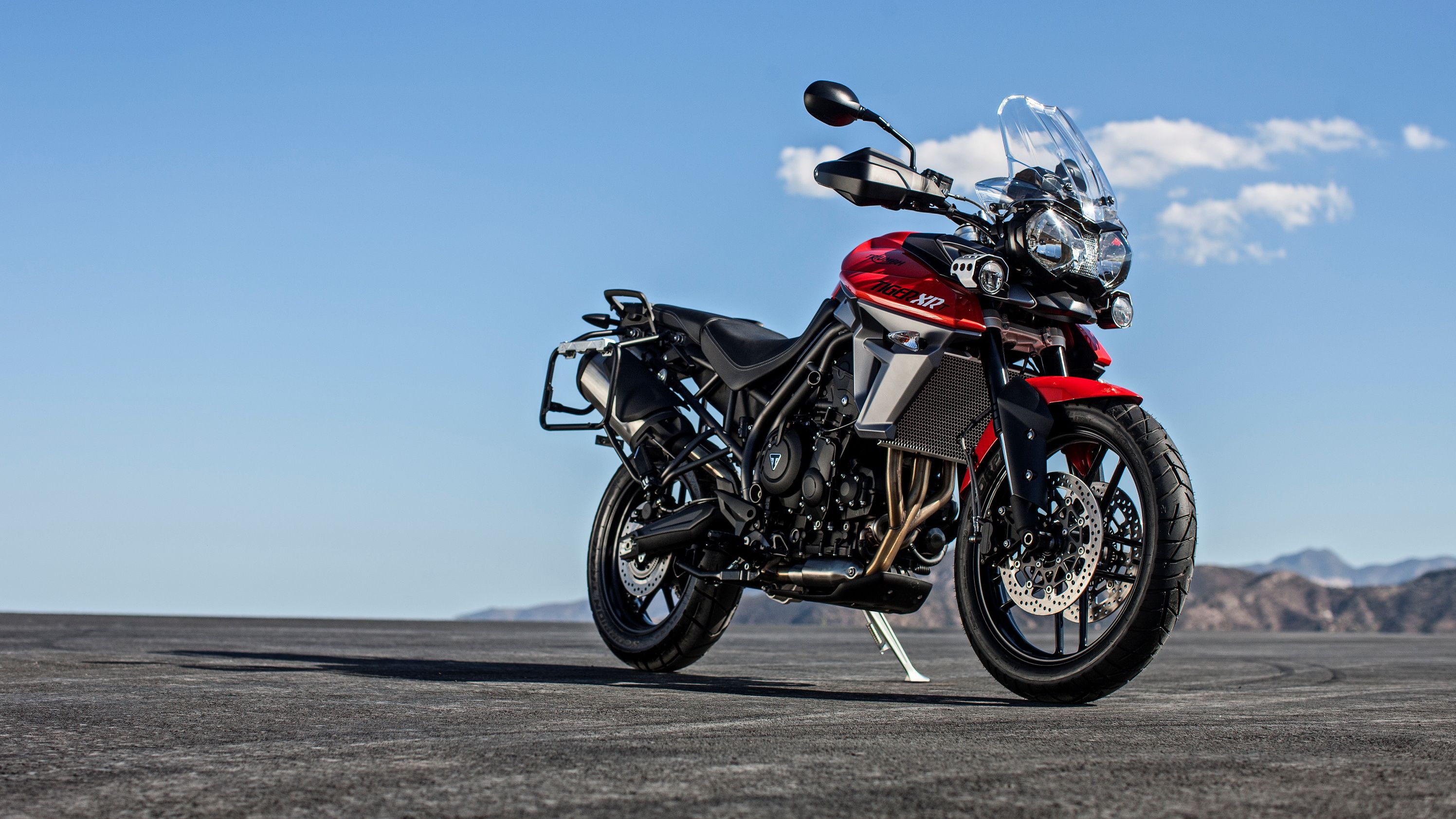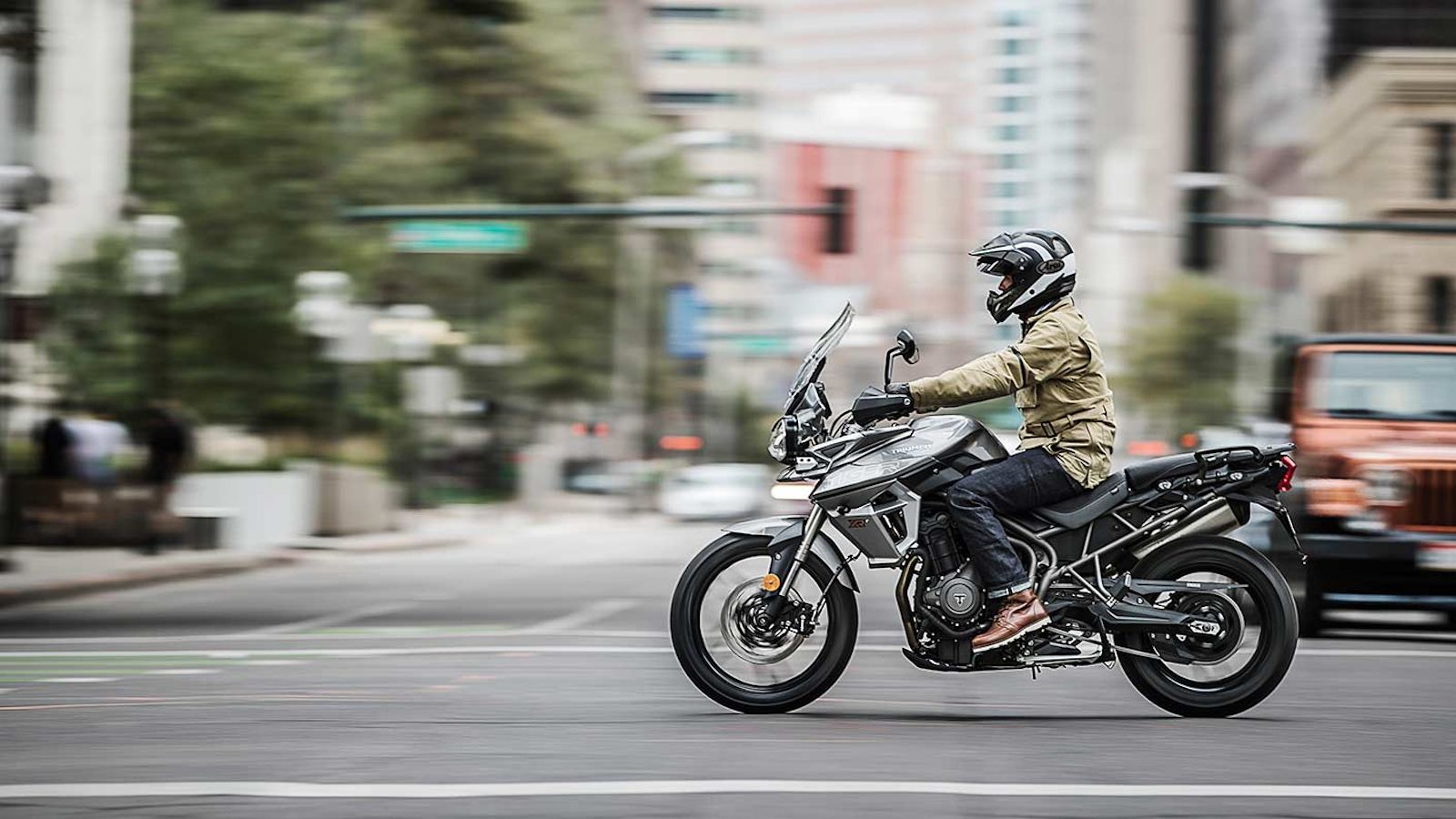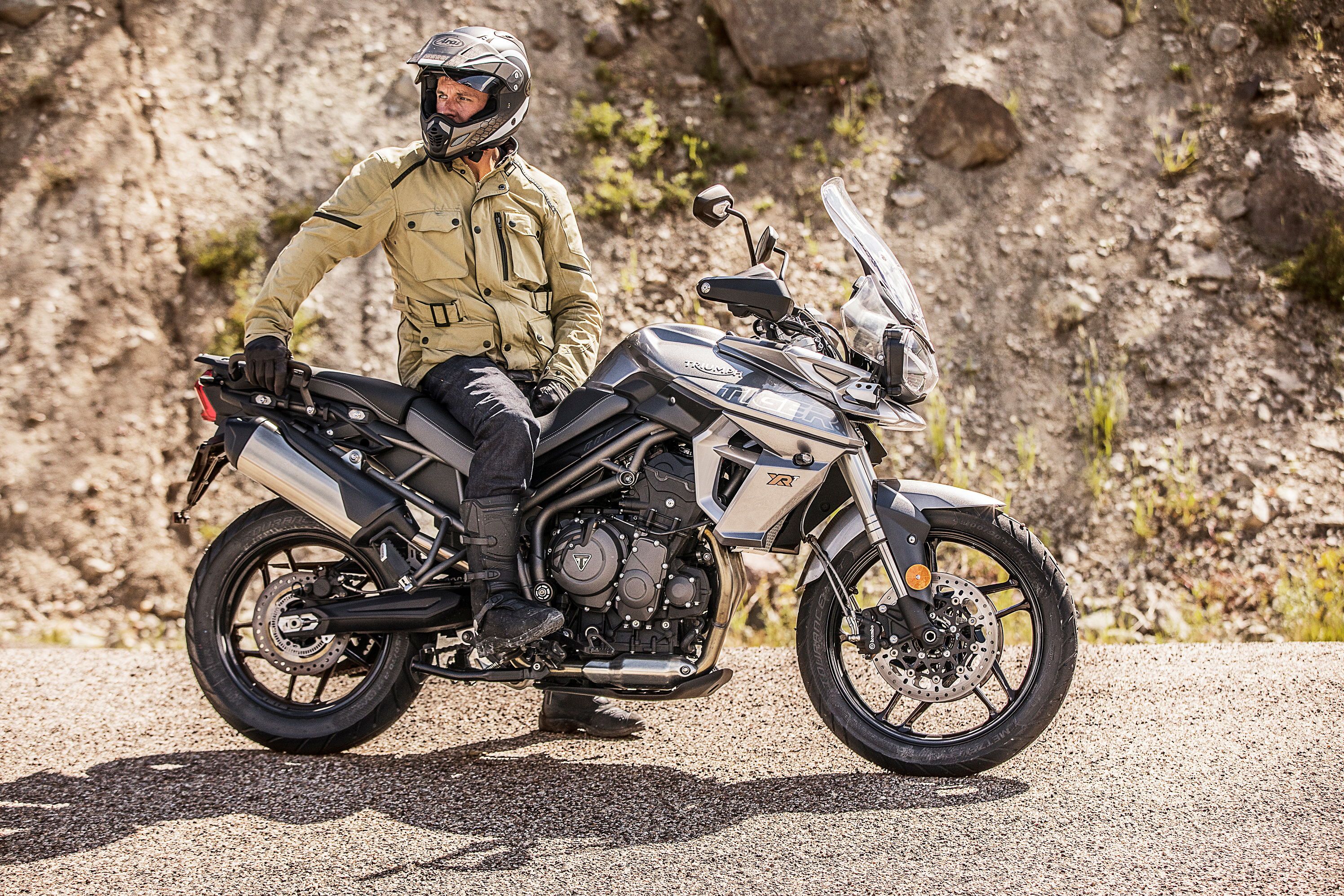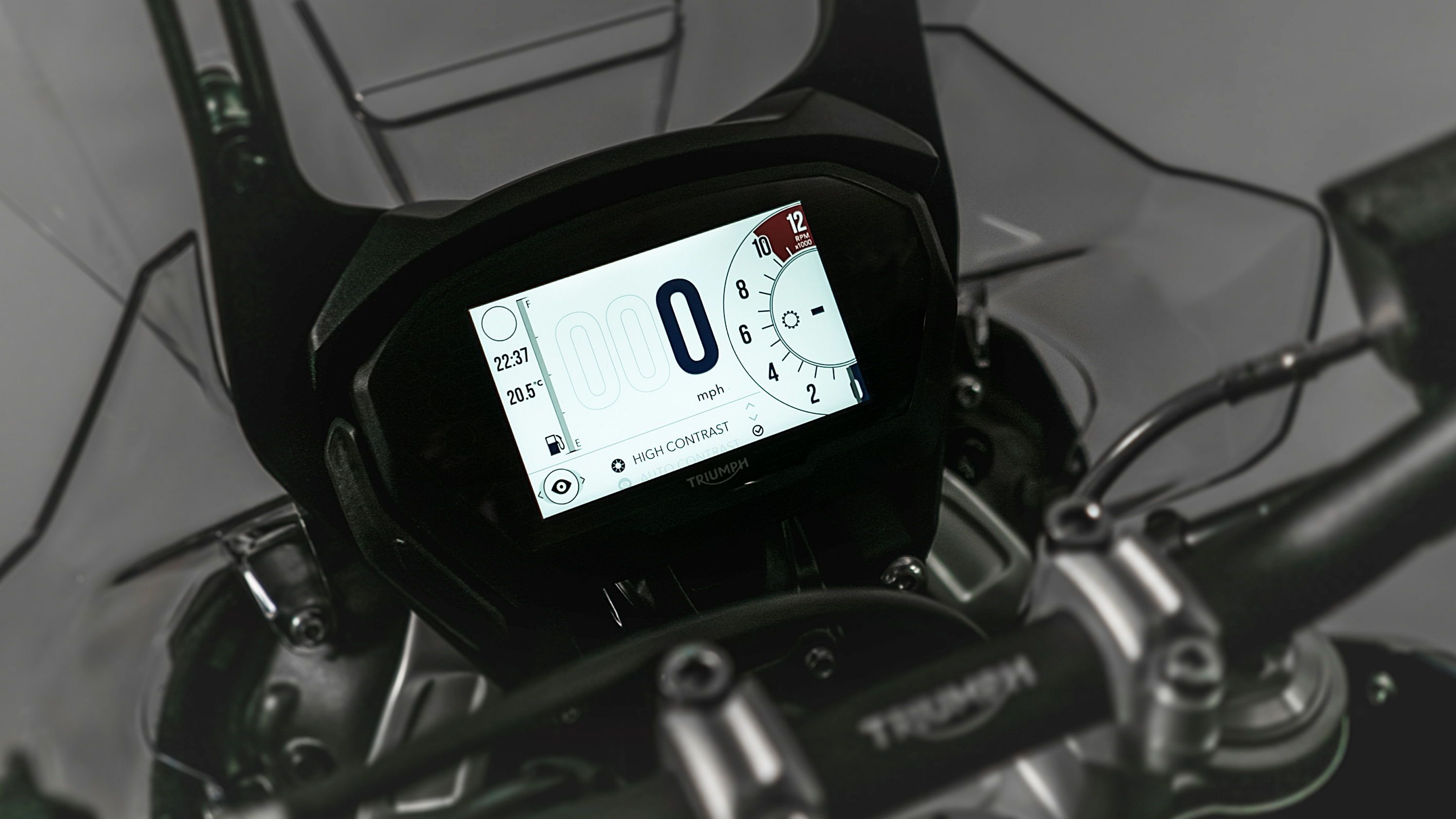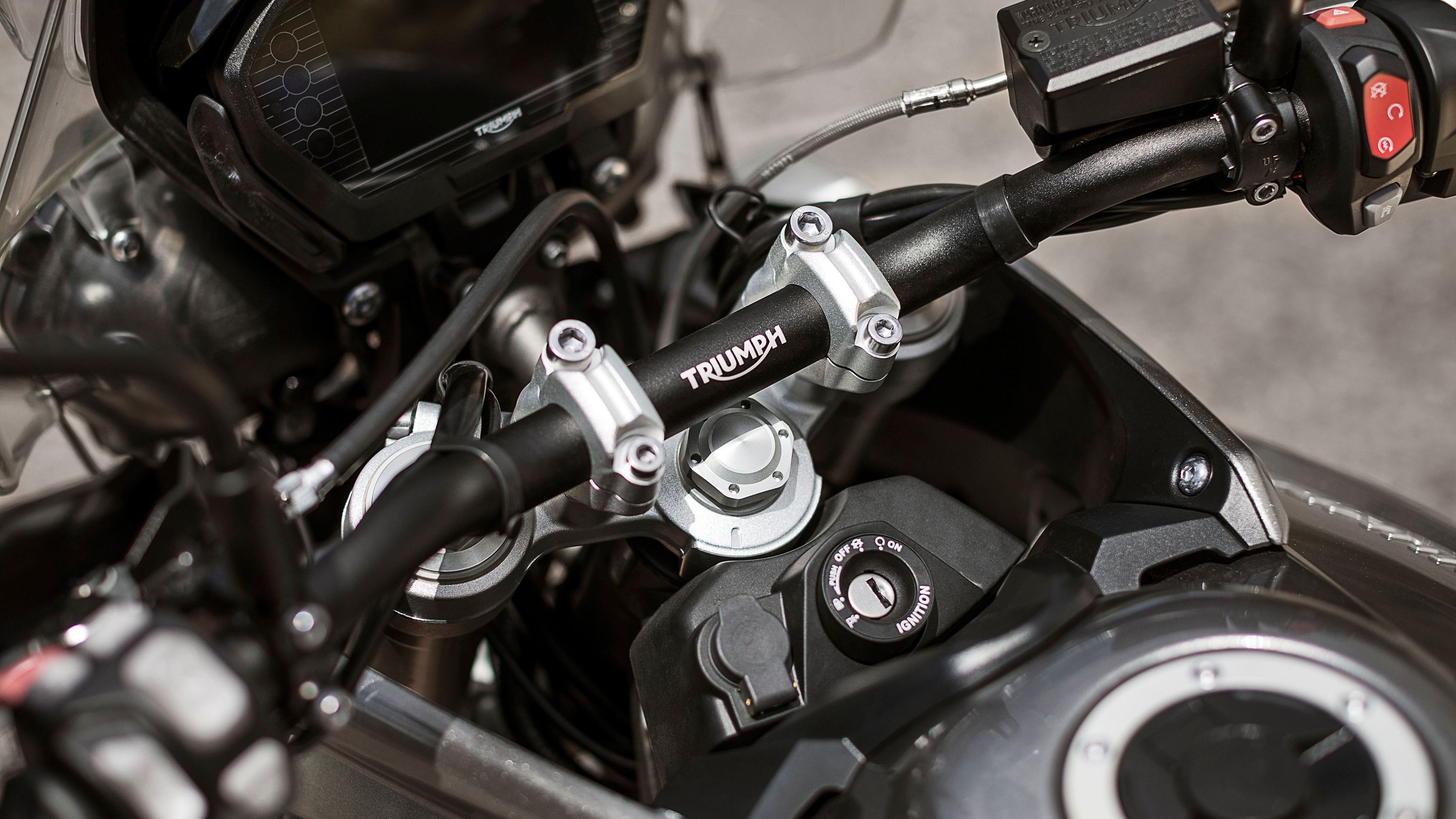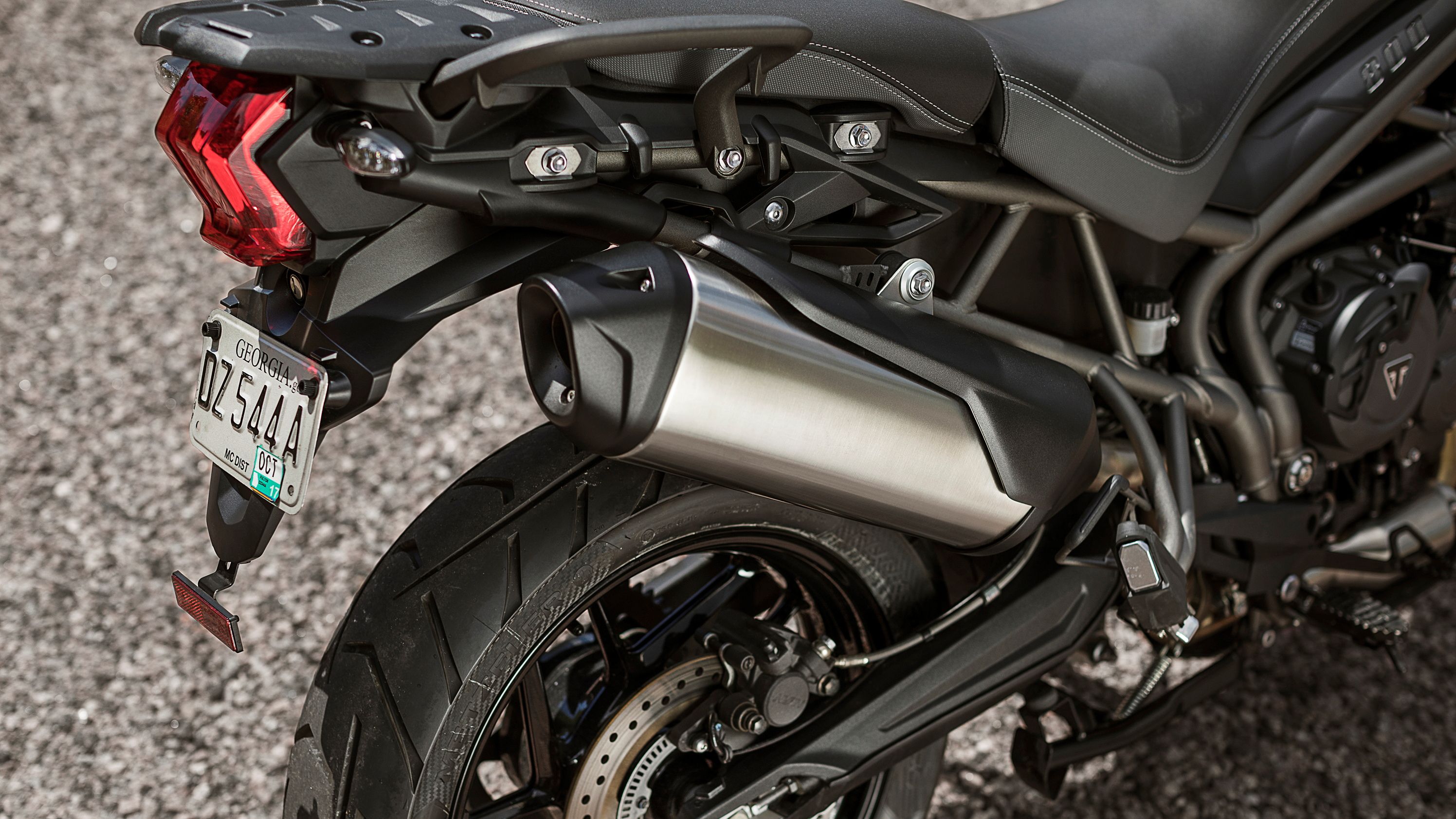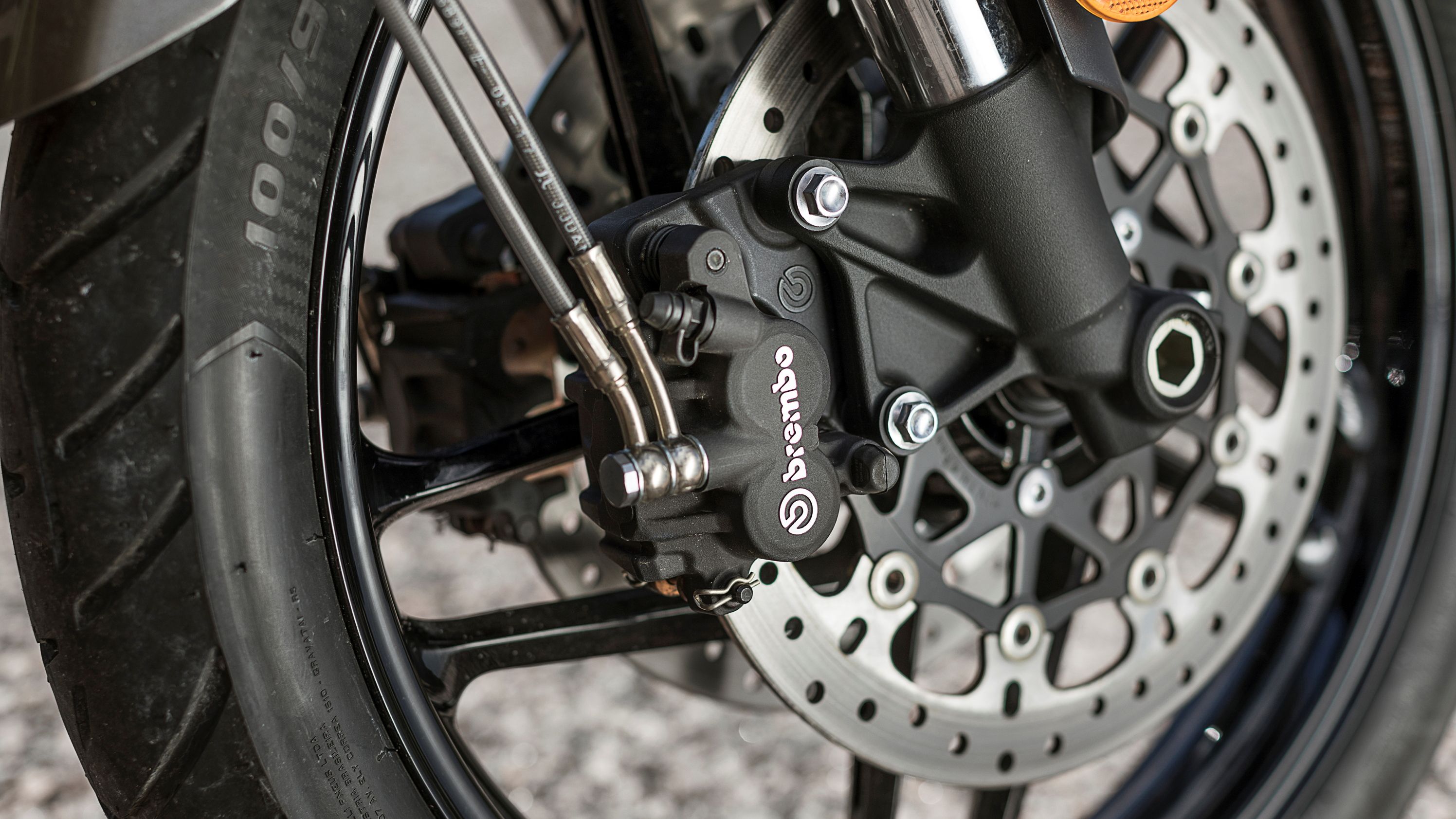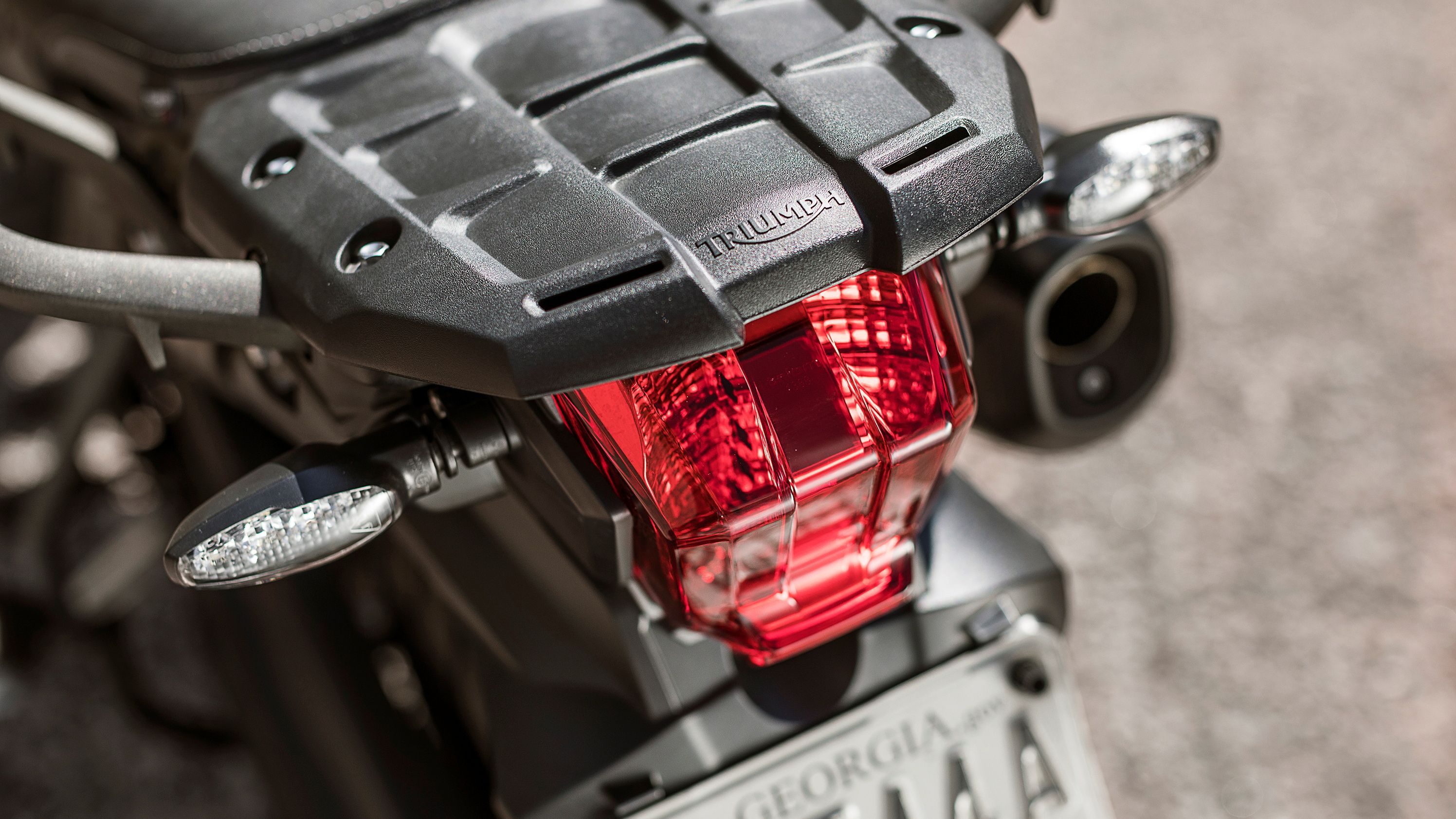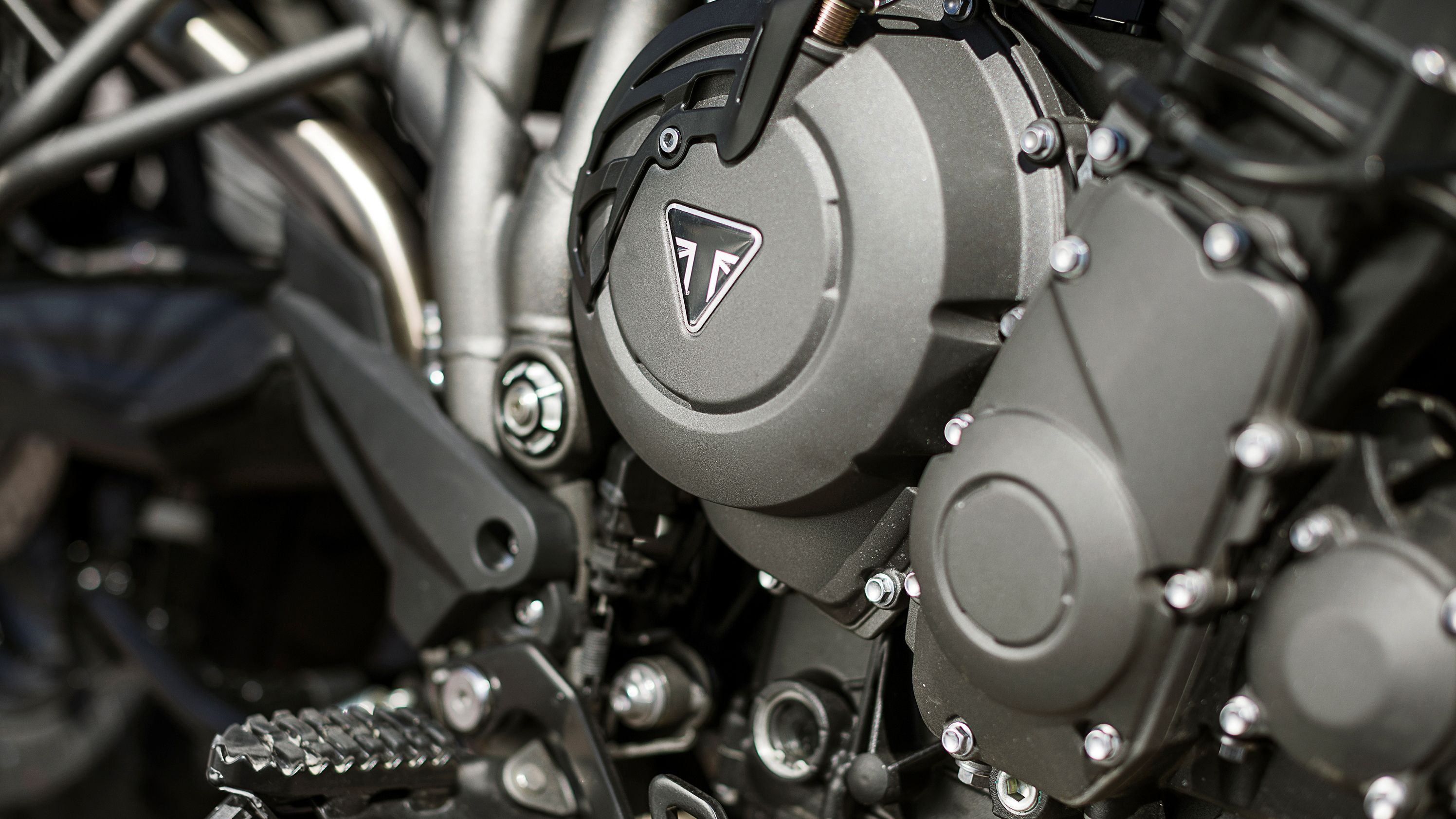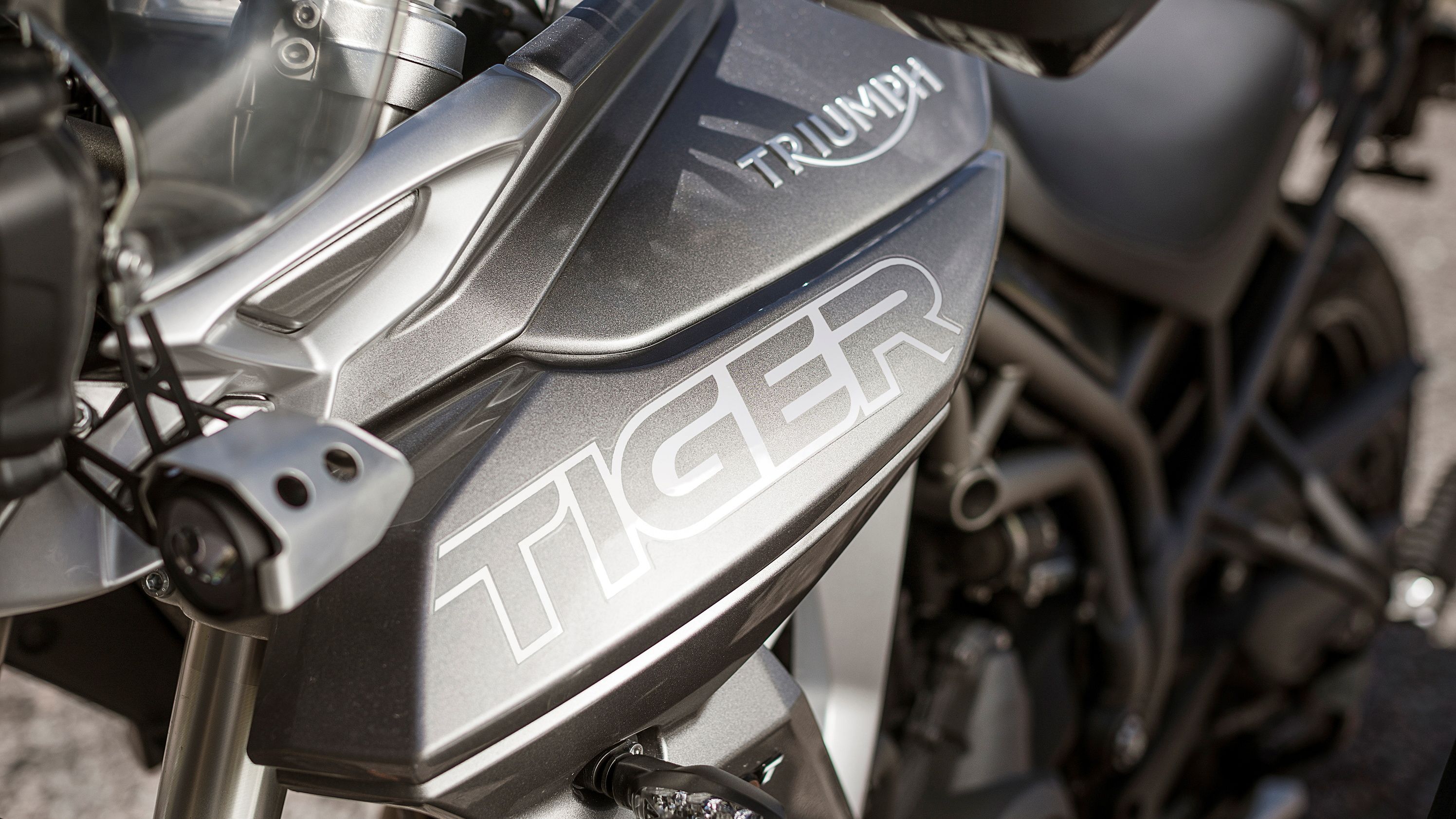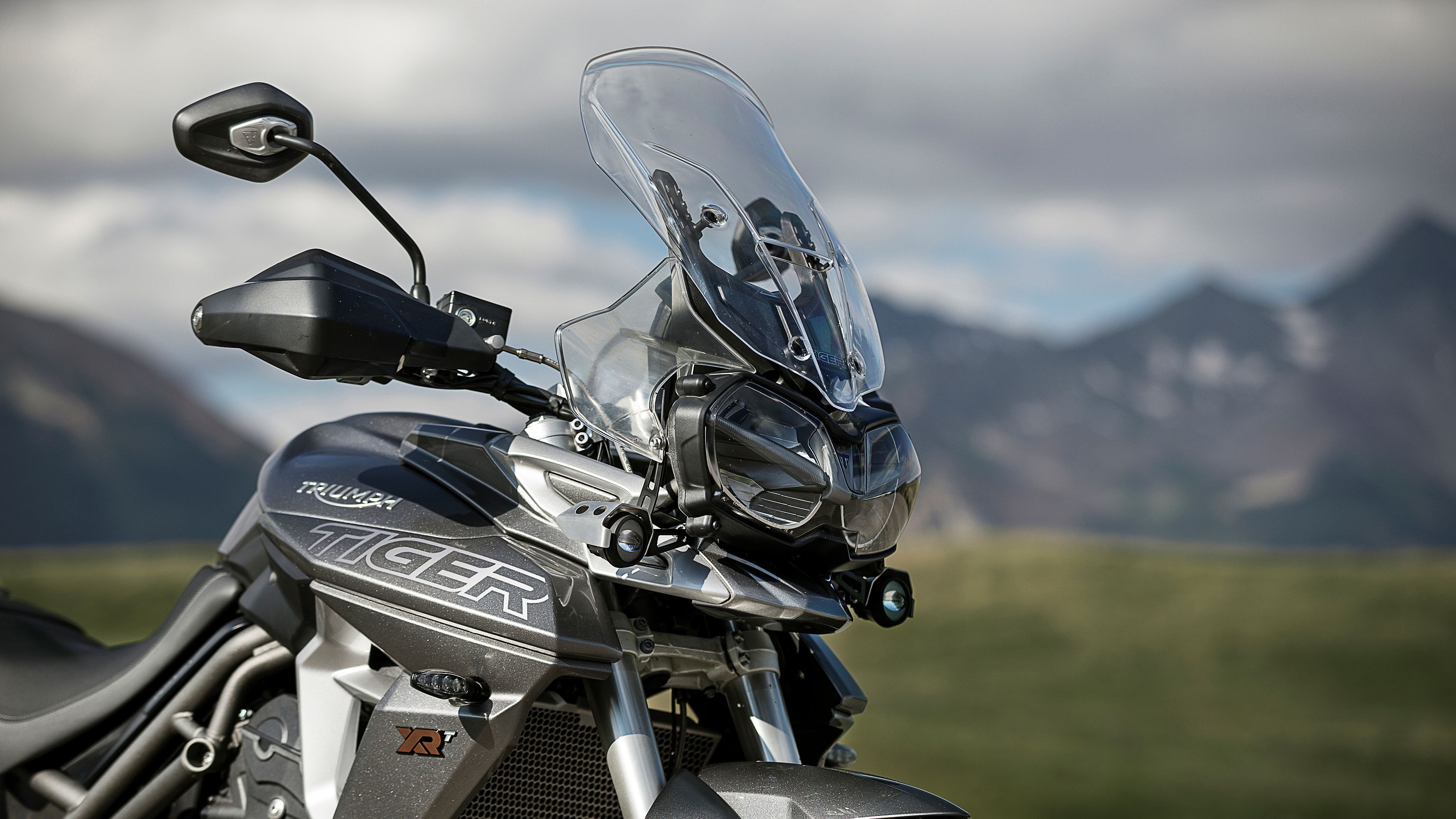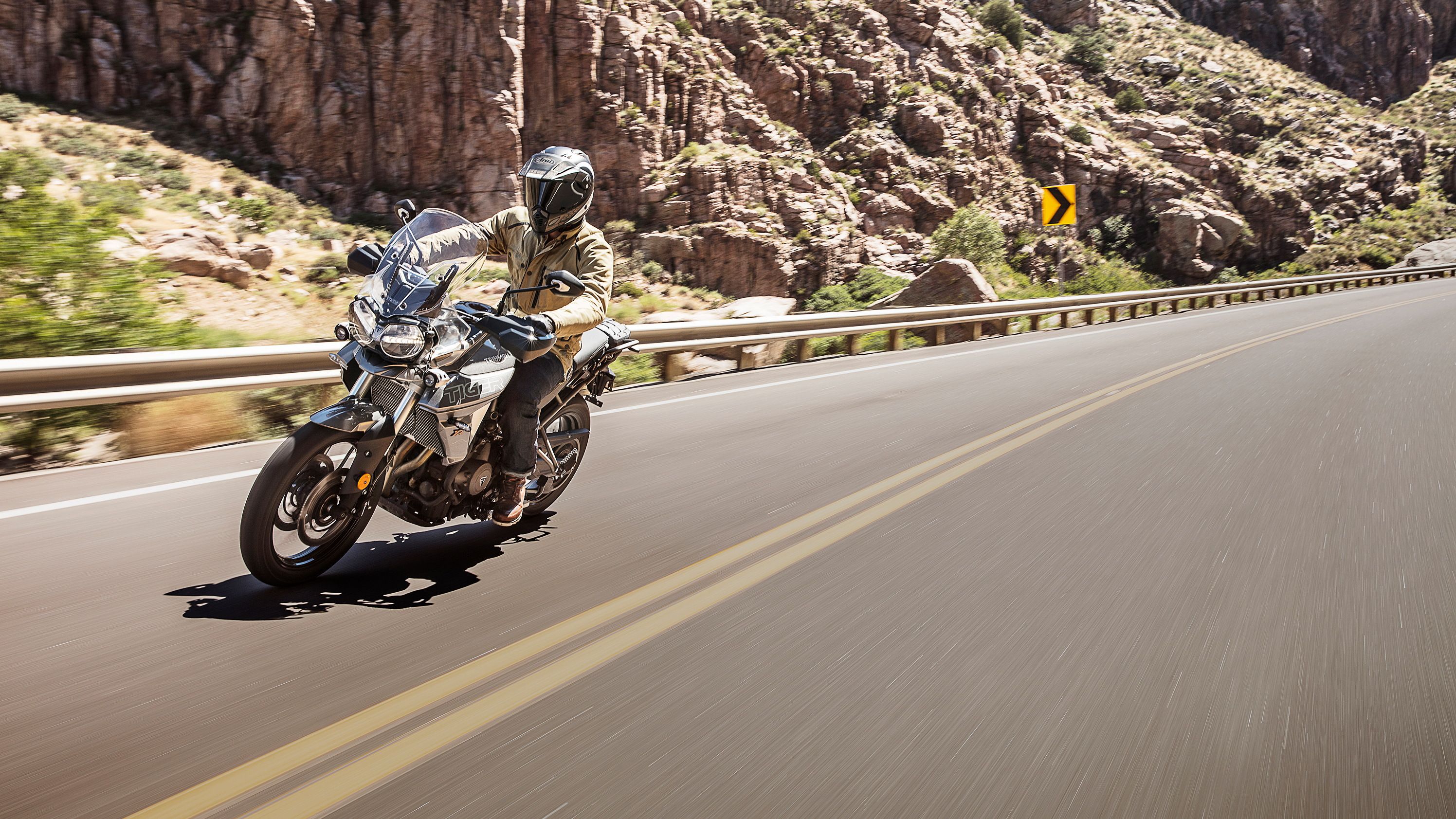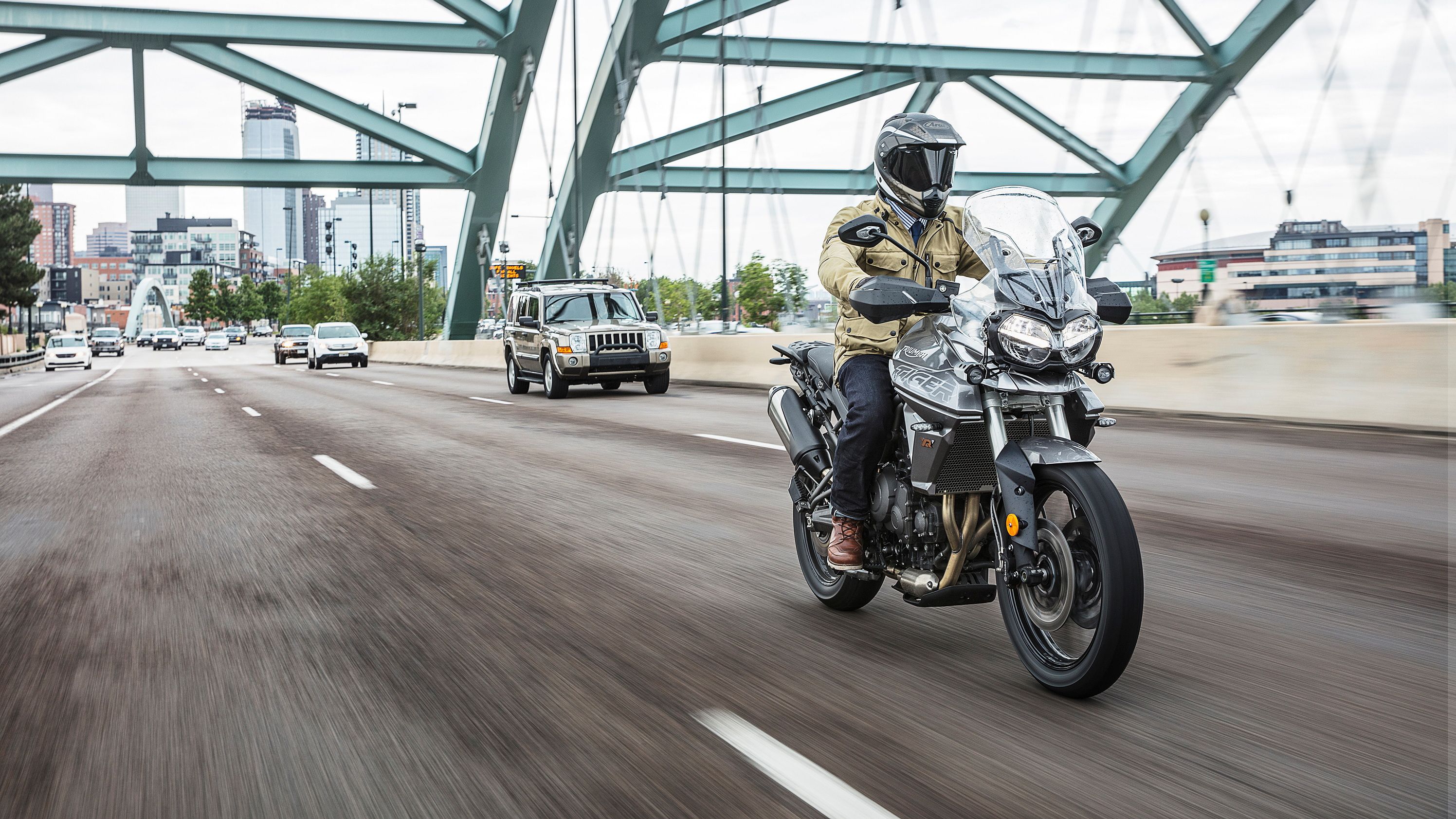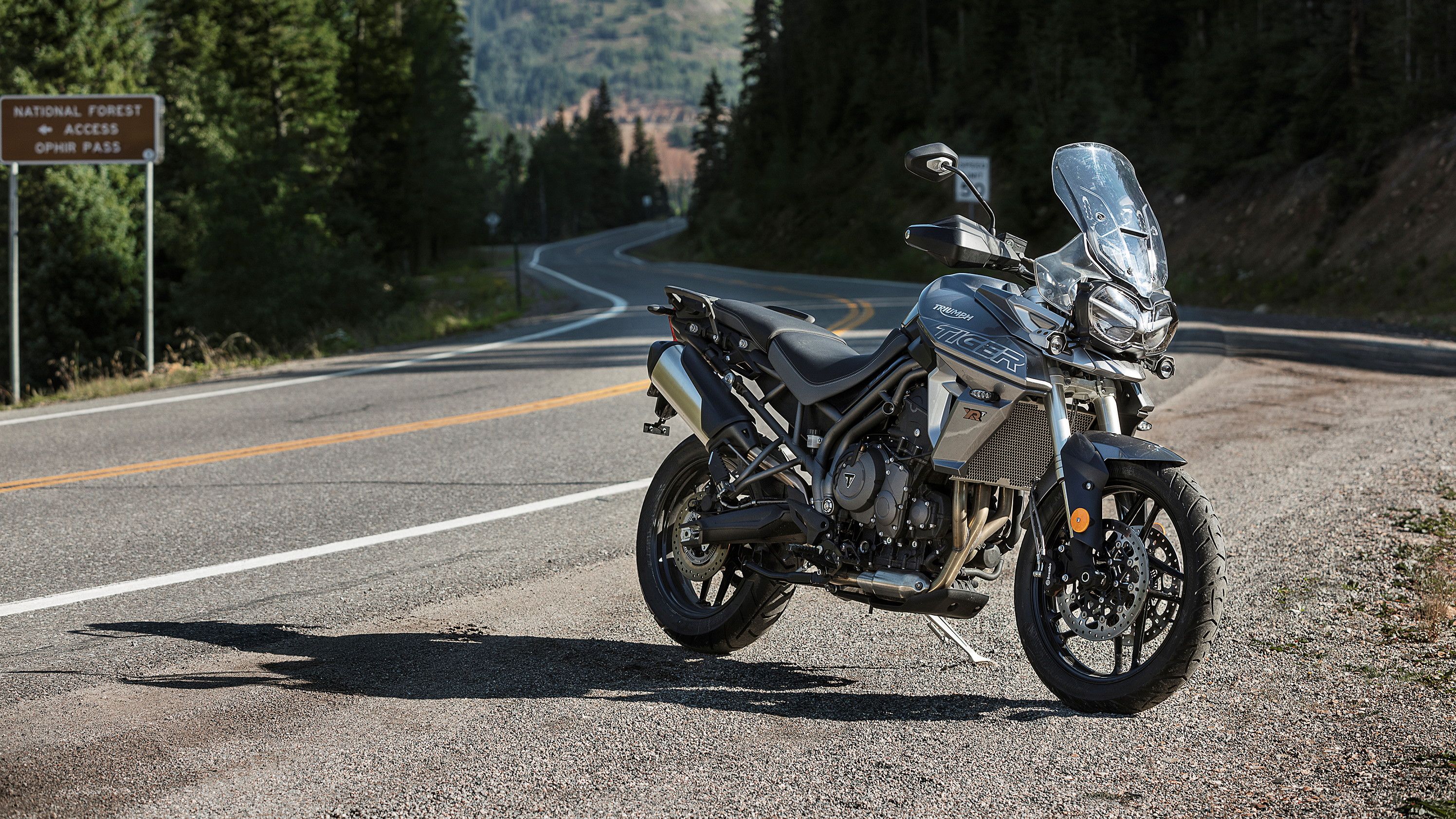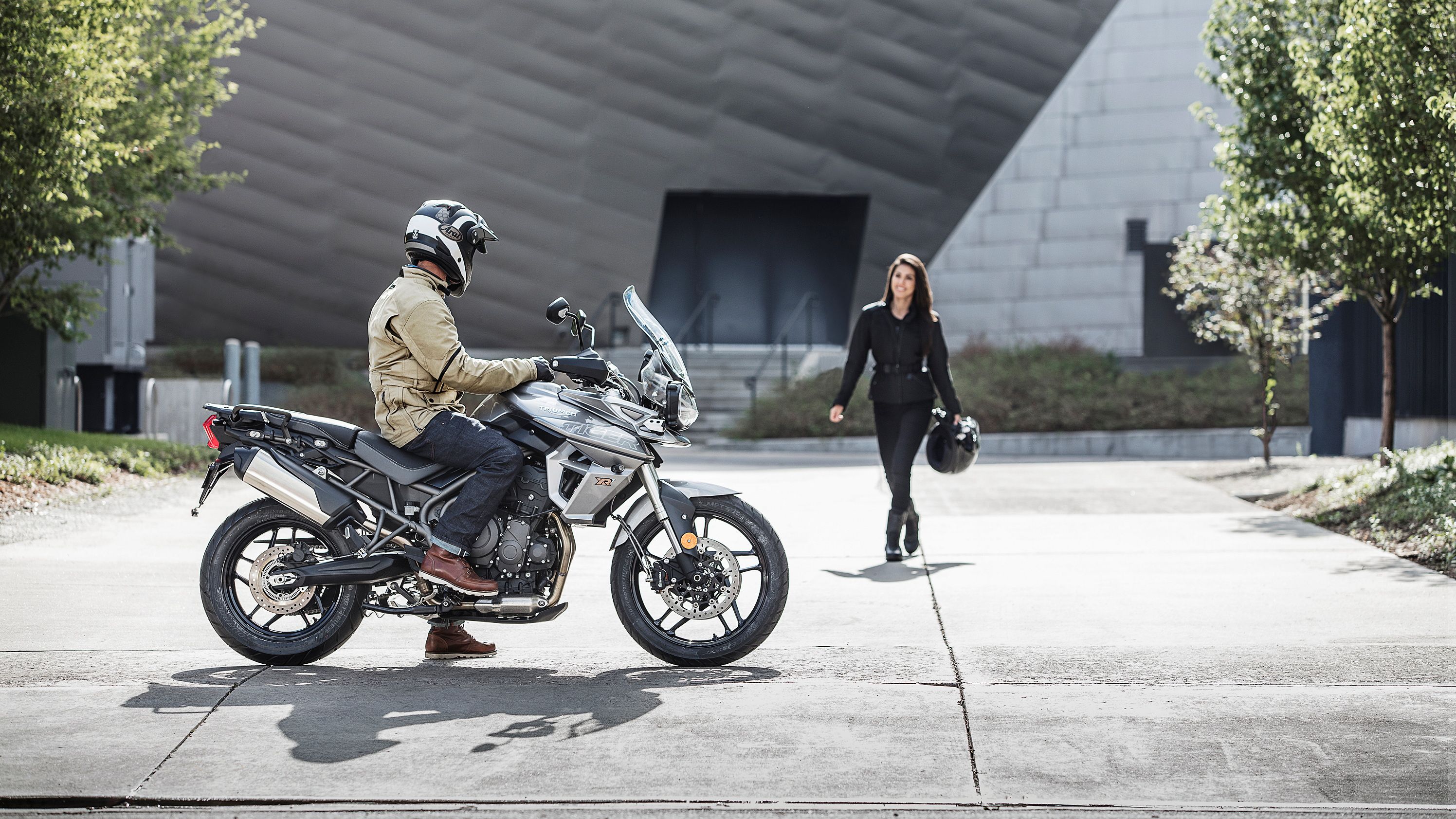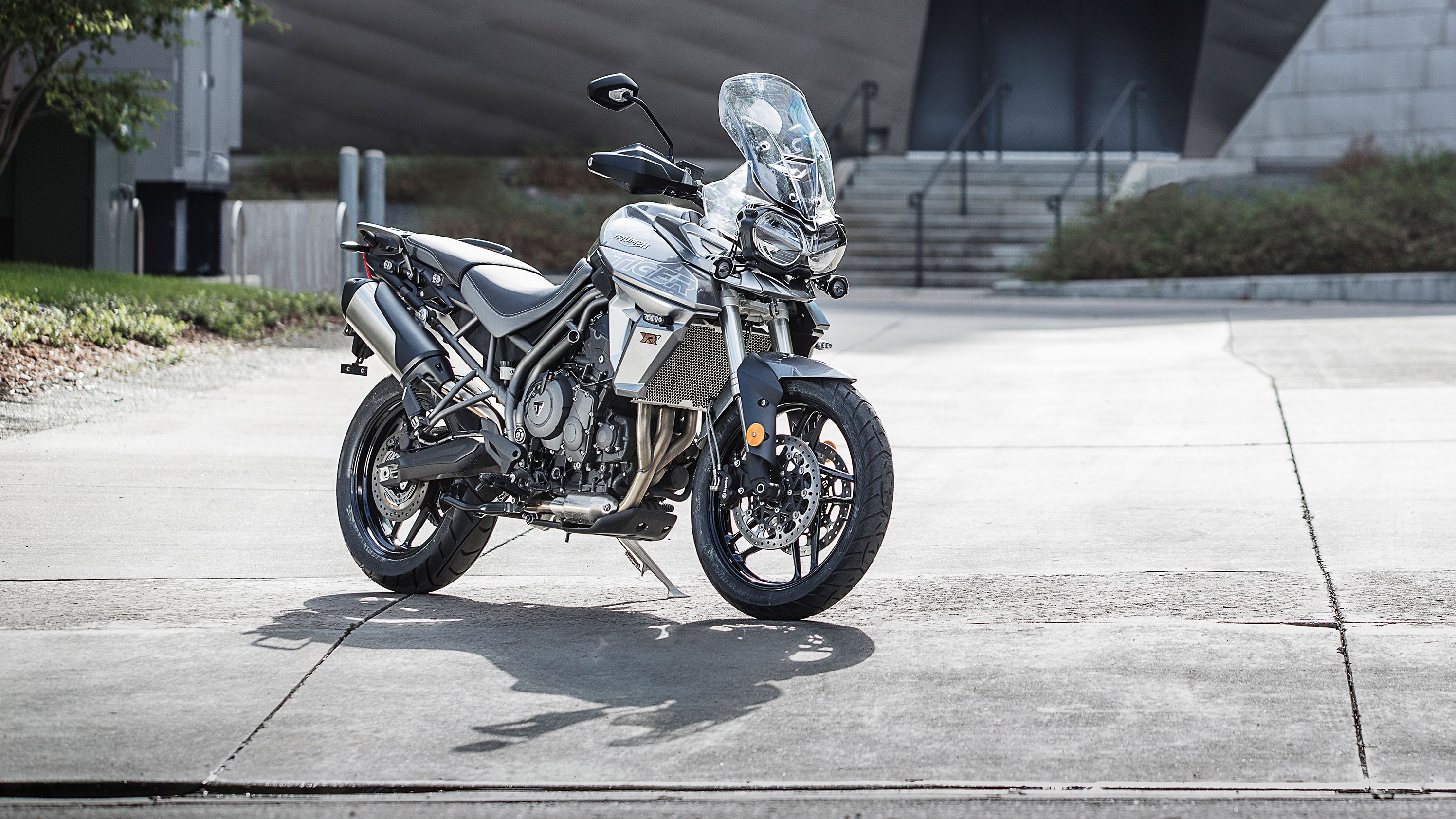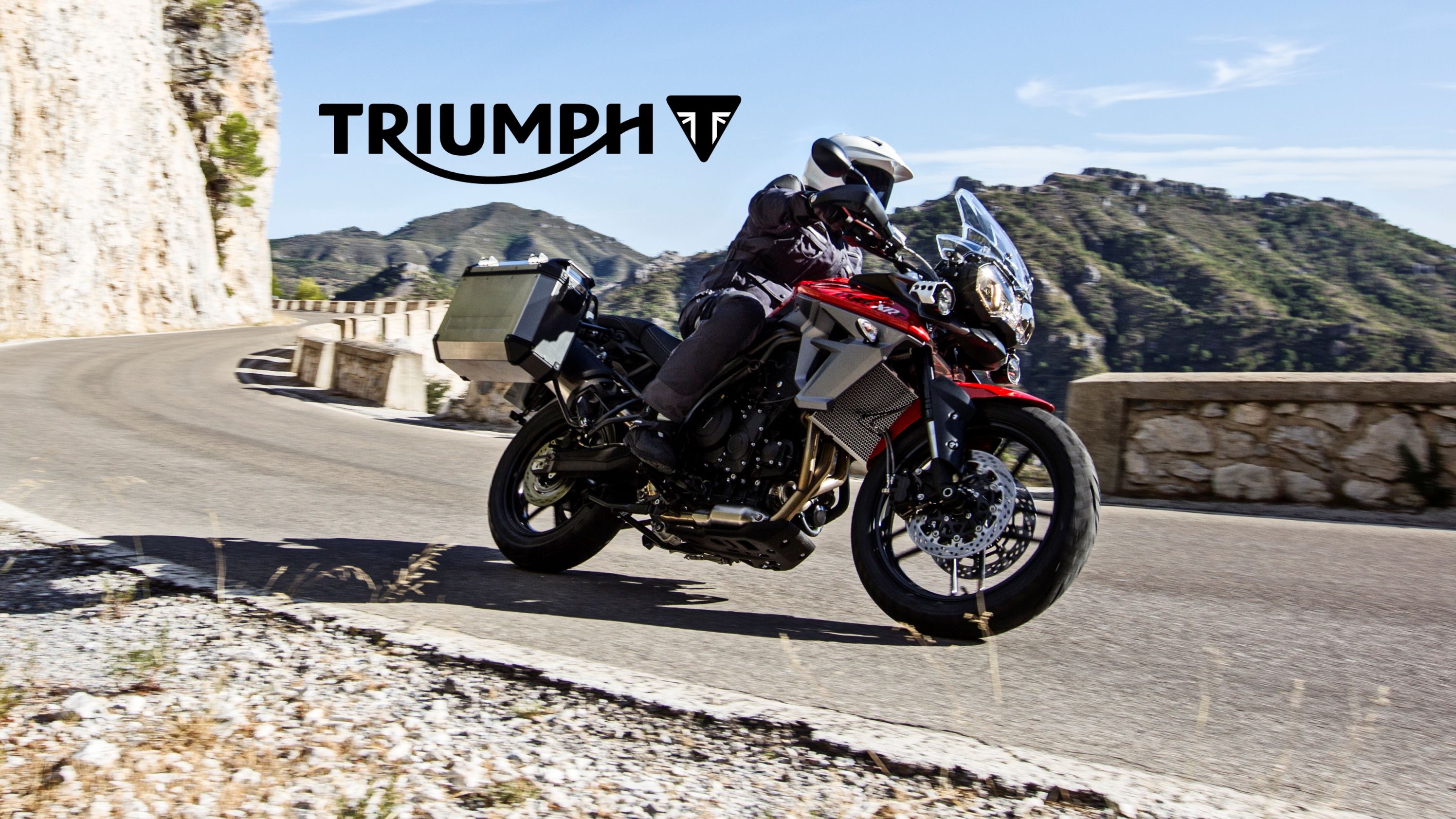Triumph updated the Tiger 800 lineup ahead of MY2018 and carried it into MY2019 with over 200 individual improvements to boost its already top-tier XRt to new heights. The factory bills this ride as its ultimate on-road adventure bike, and it justifies that position with all the comfort and safety equipment it has to offer along with newly designed bodywork for some fresh visual appeal. Power comes from a next-gen, 800 cc plant, and it has a full electronics suite to help keep it under control and allow you to get the most out of the machine.
2018 - 2019 Triumph Tiger 800 XRt
- Make: Array
- Model: 2018 - 2019 Triumph Tiger 800 XRt
- Segment: Array
- Engine/Motor: inline-3
- [do not use] Vehicle Model: Array
Triumph Tiger 800 XRt Design
The Tiger 800 XRt presents the typical adventure-bike profile complete with a tall fuel-tank hump and upswept rear end, though it leads off with a blunt nose in contrast with the bird's beak fairing favored by the off-road versions of the Tiger 800. Splashguard-style supports carry a close-fit front fender and protect the swept areas of the inverted fork tubes from grime and grit. The blunt nose houses a pair of goggle-like headlights with LED tech for both the DRLs and front turn signals to make sure you can see and be seen.
Up top, a vented windscreen shunts the incoming air over your head while a pair of lateral deflectors widen the weather pocket to give your upper body even more of a break, and the screen itself comes with a five-way adjuster to allow you to dial in for your body type. The factory didn't stop there; it chucked on adjustable handlebars and a seat that can be set to 31.88 inches off the deck or cranked up to 32.67 inches high. Even the clutch and brake levers are adjustable, and all together, these features allow you to shape the rider's triangle to suit.
The protection continues with stock hand guards that divert the wind from your hamburger shovels, and the icing on this cake would be the heated handgrips that make cold-weather riding even more tolerable. Behind the glass, a new, full-color TFT screen manages all the instrumentation, and is adjustable in its tilt angle for a final ergonomic tweak.
A five-gallon fuel tank defines the flyline ahead of a precipitous drop to the saddle that's nicely beveled to leave plenty of thigh room and enable some moderate body English. Oh, and the rider triangle is such that you can even pilot it standing on the footpegs for technical work to wrap up the ergonomic features.
The exposed frame members lend the entire Tiger family a certain industrial pragmatism typical of a large percentage of British machines. That pragmatism continues into the subframe that lofts the pillion and comes complete with large J.C. handles and fold-up footpegs to keep your passenger secure. At the tip of the tail, a small luggage rack provides some open-air cargo capacity above the LED taillight and blinkers with a short mudguard that doubles as the plateholder. Overall, the impression I get from the look is that of a practical ride that prioritized function over form, as is appropriate for a adventuresome ride such as this.
Triumph Tiger 800 XRt Chassis
The main structure and subframe of the Tiger 800 XRt are made from tubular-steel members in a Trellis format for the strength and rigidity it offers while leaving plenty of room for the innards. A cast-aluminum, yoke-style swingarm articulates the rear wheel to complete the skeleton and help keep unsprung weight low. A short rake angle of 23.8 degrees on the steering head with an also-short 3.41 inches of trail makes this Tiger very eager in the corners and give it a flickable nature that defies its relatively tall overall height.
New ten-spoke, cast-aluminum rims round out the rolling chassis with a 19-inch wheel up front opposite a 17-inch wheel out back, and this new gen runs with Metzeler Tourance tires in a 100/90 and 150/70 on the front and rear, respectively. Also new for this generation are the inverted Showa forks that deliver adjustable compression- and rebound-damping along with a 7.09-inch (180 mm) stroke that'll tolerate some pretty rough tarmac.
In the rear, Showa makes another showing with its preload-adjustable monoshock that turns in 6.69 inches (170 mm) of travel. As for the brakes, Brembo delivers the goods with dual 305 mm discs and twin-pot anchors to slow the front wheel and a 255 mm disc and single-piston caliper out back, all under the protection of the switchable ABS feature.
|
Frame: |
Tubular steel trellis frame |
|
Swingarm: |
Twin-sided, cast aluminum alloy |
|
Front Suspension: |
Showa 1.69 in (43 mm) upside down forks, with adjustable rebound and compression damping, 7.09 in (180 mm) travel |
|
Rear Suspension: |
Showa monoshock with hydraulically adjustable preload, 6.69 in (170 mm) rear wheel travel |
|
Rake: |
23.8º |
|
Trail: |
3.41 in (86.6 mm) |
|
Front Wheel: |
Cast aluminum alloy 10-spoke 19 x 2.5 in |
|
Rear Wheel: |
Cast aluminum alloy 10-spoke 17 x 4.25 in |
|
Front Tire: |
100/90-19 |
|
Rear Tire: |
150/70 R17 |
|
Front Brakes: |
Dual 305 mm floating discs, Brembo 2-piston sliding calipers, switchable ABS |
|
Rear Brakes: |
Single 255 mm disc, Nissin single piston sliding caliper, switchable ABS |
Triumph Tiger 800 XRt Drivetrain
The electronic safety equipment continues into the engine-controls with a switchable traction-control feature that monitors wheel speeds and intervenes when slippage is detected. An engine immobilizer delivers peace of mind as a theft deterrent, and there's a five-way riding mode feature that lets you dial in for the riding conditions and preference with a rider-tunable profile for complete control over delivery.
Power comes from an inline triple to the tune of 95 ponies at 9,500 rpm and 58 pound-feet of torque at 8,050, which clearly indicates that this is a rev-loving engine that comes alive at the top end. In order to help the bottom end, the factory shortened the first-gear ratio so you can have greater control off-road and better holeshots on the pavement.
The bores mike out at 74.05 mm with 61.9 mm strokes that give a total displacement of 800 cc and the 11.3-to-1 compression ratio trends toward the top of the range so it'll put you at the premium pump when it's time for a fill-up. Dual over-head cams time the 12-valve head and a water-jacket and radiator deal with the waste heat. A six-speed gearbox sends power to the rear wheel via O-ring chain drive, and top speed is something in the neighborhood of 128 mph.
|
Engine: |
Liquid-cooled, 12 valve, DOHC, in-line 3-cylinder |
|
Displacement: |
800 cc |
|
Bore x Stroke: |
2.92 in (74.05 mm) x 2.44 in (61.9 mm) |
|
Compression: |
11.3:1 |
|
Max Power: |
95 hp (70 kW) @ 9,500 rpm |
|
Max Torque: |
58 lb-ft (79 Nm) @ 8,050 rpm |
|
System: |
Multipoint sequential electronic fuel injection |
|
Exhaust: |
Stainless steel 3 into 1 header system, side mounted stainless steel muffler |
|
Final Drive: |
O-ring chain |
|
Clutch: |
Wet, multi-plate |
|
Gearbox: |
6-speed |
Triumph Tiger 800 XRt Pricing
The 2019 Tiger 800 XRt rolls in a choice of Crystal White, Matte Cobalt Blue or Silver Ice. No matter which color strikes your fancy, you can expect to shell out $15,700 MSRP.
|
Instrument Display and Functions: |
TFT multi-functional instrument pack with digital speedometer, trip computer, digital tachometer, gear position indicator, fuel gage, service indicator, ambient temperature, clock and five rider modes (Road/Off-road/Sport/Track/Rider-Customisable) |
|
Colors: |
Silver Ice, Matte Cobalt Blue, Crystal White |
|
Price: |
$15,700 |
Triumph Tiger 800 XRt Competitors
Usually I'd go to Ducati for my head to head for one of the Tigers, but this time I wanted to give the Honda Africa Twin a shot, so here we go. Like the Trumpet, the “AT” runs with a blunt nose that puts it in the minority within the ADV bike segment, but I like the look, me. Honda keeps to the rally style with a narrow windscreen atop the front fairing, and it falls short of the protection offered by the extra deflectors on the Tiger.
Laced wheels give the AT more of an off-road panache in spite of its street-centric bias, and in profile, the AT rocks the lines that are so typical in this genre. Stock handguards provide a little extra protection, but it looks like Honda falls short in the comfort department since I don't see any heated handgrips. To be fair, the Red Rider's saddle height is adjustable, so at least you can tune the rider's triangle a bit.
Suspension travel is generous at 9.1 inches and 8.7 inches on the front and rear, respectively, but again Honda falls short 'cause its suspension comes with only the obligatory spring preload adjuster out back. Power comes from a 998 cc Unicam plant with 93 horsepower and 73 pounds o' grunt against the Tiger's 95/58, but that's to be expected considering the difference in engine configuration; the twin is going to have more torque, in general. Honda delivers variable torque control with a quartet of power-delivery profiles, and it scores at the checkout with a $13,599 starting price or $14,399 if you go for the DCT model, for which Triumph has no answer.
He Said
“ At this price point, a grand here or there isn't liable to matter much; certainly not enough to overcome brand loyalty one way or the other, but I think Trumpet has a hit on its hands with its top-tier Tiger. It's got safety and comfort in the bag, and honestly, for road work, the Tiger's torque figures can be filed under the “good enough” category.”
She Said
My wife and fellow motorcycle writer, Allyn Hinton, says, “The Tiger 800 XRt is Triumph's 800 cc top-of-the-line, on-road-oriented adventure bike. The seat very comfortable and the triangle has you upright in a good posture for long-range riding. The new suspension is nice and gives you a smooth ride. The changes to the engine give you smooth power delivery and it's surprisingly flickable. As a touring bike, the Tiger 800 XRt is a winner.”
Triumph Tiger 800 XRt Specifications
|
Engine & Drivetrain: |
|
|
Engine: |
Liquid-cooled, 12 valve, DOHC, in-line 3-cylinder |
|
Displacement: |
800 cc |
|
Bore x Stroke: |
2.92 in (74.05 mm) x 2.44 in (61.9 mm) |
|
Compression: |
11.3:1 |
|
Max Power: |
95 hp (70 kW) @ 9,500 rpm |
|
Max Torque: |
58 lb-ft (79 Nm) @ 8,050 rpm |
|
System: |
Multipoint sequential electronic fuel injection |
|
Exhaust: |
Stainless steel 3 into 1 header system, side mounted stainless steel muffler |
|
Final Drive: |
O-ring chain |
|
Clutch: |
Wet, multi-plate |
|
Gearbox: |
6-speed |
|
Chassis: |
|
|
Frame: |
Tubular steel trellis frame |
|
Swingarm: |
Twin-sided, cast aluminum alloy |
|
Front Suspension: |
Showa 1.69 in (43 mm) upside down forks, with adjustable rebound and compression damping, 7.09 in (180 mm) travel |
|
Rear Suspension: |
Showa monoshock with hydraulically adjustable preload, 6.69 in (170 mm) rear wheel travel |
|
Rake: |
23.8º |
|
Trail: |
3.41 in (86.6 mm) |
|
Front Wheel: |
Cast aluminum alloy 10-spoke 19 x 2.5 in |
|
Rear Wheel: |
Cast aluminum alloy 10-spoke 17 x 4.25 in |
|
Front Tire: |
100/90-19 |
|
Rear Tire: |
150/70 R17 |
|
Front Brakes: |
Dual 305 mm floating discs, Brembo 2-piston sliding calipers, switchable ABS |
|
Rear Brakes: |
Single 255 mm disc, Nissin single piston sliding caliper, switchable ABS |
|
Dimensions & Capacities: |
|
|
Width Handlebars: |
31.3 in (795 mm) |
|
Height Without Mirror: |
53.15 in (1,350 mm) |
|
Seat Height: |
31.88 - 32.67 in (810 - 830 mm) |
|
Wheelbase: |
60.24 in (1,530 mm) |
|
Dry Weight: |
446 Lbs (202 kg) |
|
Tank Capacity: |
5 Gal. |
|
Top Speed: |
128 mph (est) |
|
Details: |
|
|
Instrument Display and Functions: |
TFT multi-functional instrument pack with digital speedometer, trip computer, digital tachometer, gear position indicator, fuel gage, service indicator, ambient temperature, clock and five rider modes (Road/Off-road/Sport/Track/Rider-Customisable) |
|
Colors: |
Silver Ice, Matte Cobalt Blue, Crystal White |
|
Price: |
$15,700 |
Further Reading
Honda Africa Twin
See our review of the Honda Africa Twin.
Triumph Tiger 800 XCa
See our review of the Triumph Tiger 800 XCa.
Triumph Tiger 800 XCx
|
|
center> |
See our review of the Triumph Tiger 800 XCx.
Triumph Tiger 800 XRx
|
|
center> |
See our review of the Triumph Tiger 800 XRx.
Triumph
Read more Triumph news.


